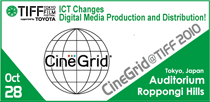2010.10.25
[Interviews]
“Let the Wind Carry Me” Interview with Kwan Pun-leung (Director) and Chiang Hsiu-chiung (Director)(10/25)


©2010 TIFF
---Mark Lee is a world-acclaimed cinematographer. What made you decide to make a documentary about him?
Chiang Hsiu-chiung (Chiang): I got to know Mark Lee just over 10 year ago, and I was inspired by his life experience and his approach to work. I always wanted to do Hou Hsiao-Hsien’s documentary, but I didn’t have the opportunity. As for Mark Lee, I wanted to make a book about him. I became acquainted with Kwan-Pun-leung when I made a short documentary. I said to him that I wanted to make Lee Ping-bin’s book, he suggested a documentary rather than a book. It was left as that for a while, but with encouragement from Kwan, I decided to sound out with Mark Lee himself.
---Have you worked with Mark Lee, Mr. Kwan?
Kwan Pun-leung (Kwan): I participated in the filming of Wong Kar-wai’s “In the Mood for Love” in the second unit. Mark Lee was in another unit as a cameraman, that’s how I got to know him. But I didn’t work with him then, but when I was filming in Taiwan, I became interested in Mark Lee because I was told he is an excellent cameraman as well as being really helpful for young crews. I met him in Hong Kong by chance, and I felt he has tender affection towards people. I got to know him more in the process of making this film, and his affection goes for not just people but for animals and plants as well. His emotions, I think, appeal deeply to the audience.
---Mark Lee in the film looks like a wolf, but his eyes are very gentle and his sensitivity shines in between words. Did this appearance and inner side spark your imagination?
Chiang: Indeed, he is a very attractive person and his aesthetic is worth sharing, that is why I wanted to make a book about him. Though I am not a writer myself, I wanted to ask someone to write it, in order to let others to know about him. Even I wanted to watch a film about him rather than making one myself. But I decided to make it myself because I know both How Hsiao-hsien, and I have been with Mark Lee for a long time.
---You have been worked with many directors, Mr. Kwan?
Kwan: I have worked on two of Stanley Kwan’s films, and one of them was a documentary. I have been involved with Wong Kar-wai’s films from the time of “Days of Being Wild” (1990). I did the retake of “Ashes of Time”(1994), and I am currently involved in filming “2046” (2004) and “My Blueberry Nights” (2007).
---You are busy both in Hong Kong and Taiwan. Is there much interaction among the film makers?
Kwan: Lee Ping-bin worked in Hong Kong. As for recording, Tu Du-che’s team often worked in Hong Kong. I don’t think there was much between Taiwan and Hong Kong.
Chiang: Kwan works a lot in Taiwan. “Zoom Hunting,” which will be shown at this festival this year, is also shot by him.
---You appeared in “Brighter Summer Day” (1991), and then worked for Hou Hsiao-hsien and Edward Yang. Do you think you have been influenced by the two?
Chiang: Edward Yang led me into the world of films, and then I worked with Hou Hsiao-Hsien. I learned the approach towards work. They are really strict with themselves, which influenced me a great deal. In terms of the style, I don’t think I was influenced by them because of the difference in the generation and tastes.
---How did you share the job in completing a film?
Kwan: I am a cinematographer and I didn’t have experience in directing a film. Chiang is not very experienced as a director either, so we just carried on without thinking about role-sharing. We flew to France when we heard that the shooting of “Flight of the Red Balloon” was going to start in France, despite the fact that funding was not secured at the point. It was then suspended when Chiang gave birth to a child. When Mark Lee received an award in Norway, we went there with him. It’s all like that. Usually Chiang is the interviewer and I am a cameraman, but as she attended on her mother at that time, she operated the camera to film her mother.
Chiang: One of the reasons for the favourable review is his good taste in the images.
---Did two of you work out the overall structure of the film?
Kwan: We had images we shot over 3 years, so we edited them little by little and thought about how to put them together. I did the opening narration, and the woman’s voice near the end is hers.
Chiang: We wrote the narration together, but the one that is read out at the end of the film is what Mark Lee said when he won the award in Norway.
(Interviewed by Seijin Akatsuka)
Let the Wind Carry Me
Film Information





